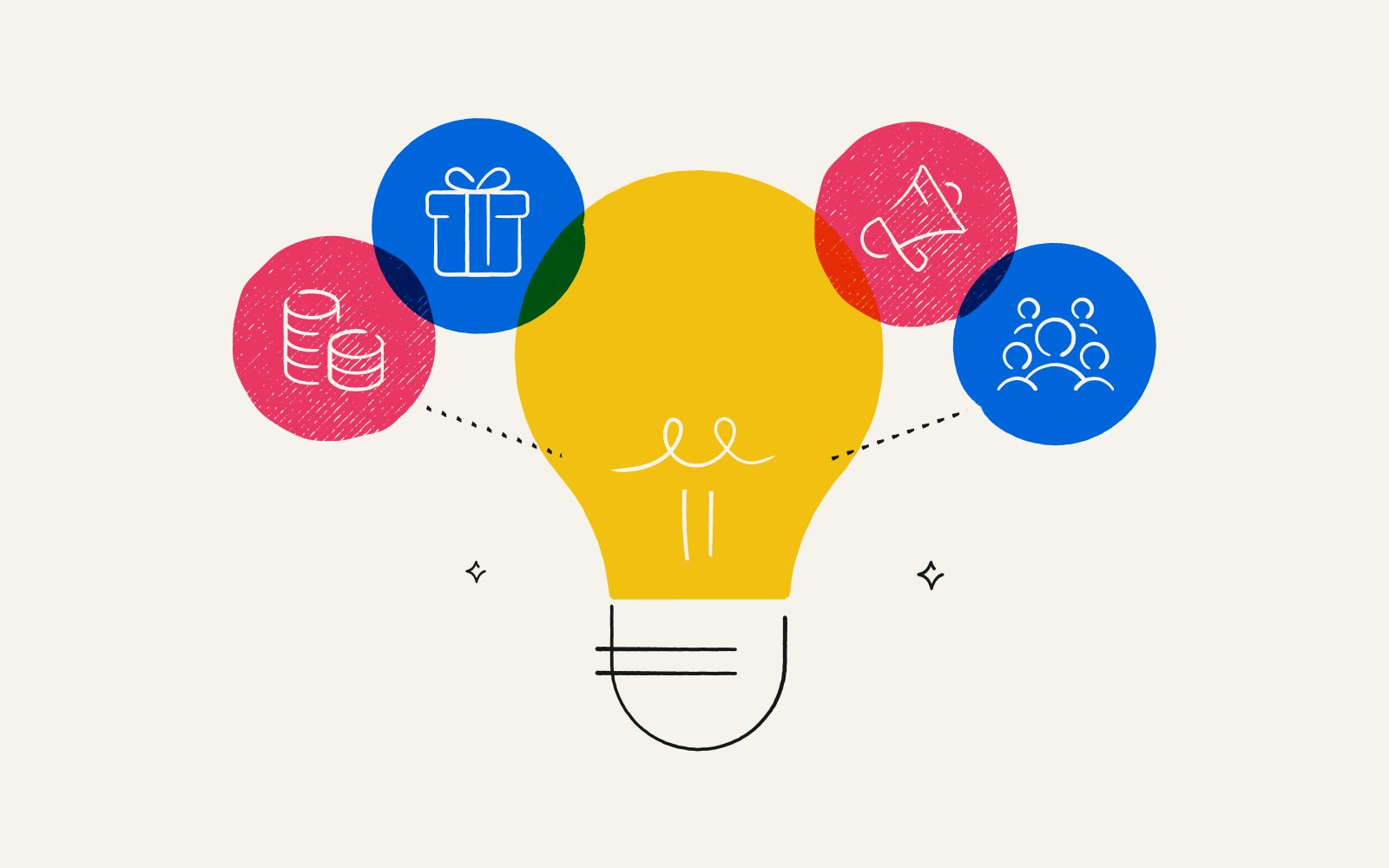12 innovative and unique referral program ideas
By Zach Links●6 min. read●Apr 18, 2025

Referral programs drive more business growth with lower acquisition costs than traditional marketing channels. But in a competitive market, simply offering a discount or a freebie isn’t always enough to stand out.
Creative referral programs do more than capture attention — they motivate customers to engage and share in ways that help your brand break through the noise, drive measurable results, and maximize return on investment (ROI).
In this article, we'll explore unique refer-a-friend program ideas to help you boost customer acquisition and customer lifetime value (LTV). From gamification to community impact, these strategies can transform satisfied customers into powerful brand advocates.
Understanding how referral programs work
Referral programs reward existing customers for bringing in new business. They formalize what already happens organically through word-of-mouth by giving people a reason to share and making it easier to do so. Most programs offer an incentive for the referrer, the person being referred, or both. Effective programs make sharing simple with personalized referral links, landing pages, and clear calls to action.
The most successful referral marketing programs create a win-win-win scenario. Existing customers get rewarded for spreading the word. New customers receive an incentive to give your product a try. And your business gains new customers at a lower cost than traditional paid advertising.
Referral programs work because they leverage trust. This built-in credibility leads to higher conversion rates and better customer retention compared to other acquisition methods.
People are 90% more likely to make a purchase when referred by a friend.
The best referral incentive ideas align your specific business goals and customer preferences. B2C companies often lean towards monetary rewards like gift cards. B2B organizations might offer perks such as exclusive access or professional development rewards that support their customers’ business goals.
Innovative referral marketing program ideas
A tried-and-true double-sided referral program can help you win new customers. But if you’re looking to build momentum and strengthen your acquisition strategy, these 12 creative referral program ideas can take your program further and help your brand stand out.
1. Gamified referral challenges
Transform referrals into a competitive game with leaderboards, badges, and special rewards for top referrers during specific challenge periods. Referral marketing tools like Lootly and Vyper can help you automate the process for a smooth, scalable program.
Companies like Dropbox have used gamification elements to drive massive growth through referrals.
Set up time-limited challenges with progressive rewards to create urgency and excitement.
Pro tip: Consider adding visual elements like progress bars or achievement levels that can boost engagement and make the experience more satisfying.
2. Community impact referrals
For each successful referral, make a meaningful donation to a cause chosen by the customer. This concept aligns with corporate social responsibility goals while incentivizing participation in a way that feels meaningful to customers.
Content that reinforces the impact of each donation can increase participation by 45%, according to a recent Stanford experiment. It’s also best to “limit the choice to two or three options,” according to the International Journal of Market Research. This way, you won’t overwhelm customers with too many options and you’ll ensure that the causes align with your brand values.
3. Personalized video thank-yous
Appreciation is always appreciated. Surprise top referrers with a short, personalized thank-you video from someone on your leadership team. This unexpected gesture creates a standout moment and builds stronger relationships through direct, meaningful recognition.
The personal connection formed through video can be far more impactful than automated rewards. A short, authentic message that mentions the customer by name and acknowledges their specific contribution will deepen loyalty in a way that feels authentic and human.
4. Anniversary bonuses
Reward referrers when the customers they bring in hit key milestones—like 6 months or 1 year. This approach encourages people to bring in quality leads who are more likely to stick around long-term, not just quick conversions.
The anniversary approach creates multiple touchpoints for engagement with both the referrer and the new customer. It reinforces the value of customer retention alongside acquisition — a natural fit for subscription and SaaS companies where LTV is especially crucial.
5. Surprise and delight rewards
Your core referral incentive ideas should be straightforward: do X, get Y. But you can still surprise referrers with unexpected bonus gifts to generate excitement, making the reward experience even more memorable and shareable.
Customers love to feel special. These surprise moments work best when they feel personal. A B2B company might send a gift card to a top referrer’s favorite coffee shop. An ecommerce brand could deliver a curated care package based on a customer’s purchase history. Small, thoughtful touches like these can turn satisfied customers into happy, loyal advocates.
6. Expertise exchange
Offer professional consultation sessions or access to industry experts as referral rewards. This approach is particularly effective for B2B companies where knowledge and expertise are highly valued.
For professional services firms, it’s a cost-effective way to provide high-perceived-value rewards. A 30-minute consultation with a senior expert might cost the company relatively little but represent significant value to the client. It could also open opportunities for upselling or expanding relationships with existing customers.
7. User-generated content incentives
Reward customers who share authentic user-generated content about your product while referring friends. This encourages both testimonials and referrals simultaneously, amplifying your marketing impact.
Companies like GoPro have seen remarkable results with UGC-driven marketing strategies. Set clear guidelines for the type of content you're looking for, whether that's social media posts, reviews, or video testimonials. Consider featuring the best submissions in your marketing materials to provide additional recognition.
8. Value-based tiers
Structure rewards based on the value of the referred customer's first purchase or contract. This incentivizes bringing in higher-value customers and aligns rewards with actual business impact.
Google Workspace (née G Suite) offers tiered and uncapped cash payouts for every referral — $8, $15, or $23, depending on the plan that’s purchased. Assuming an even distribution across the three plans, Google makes $12/user/month from the end user — a 14x ROI for Google in annual recurring revenue (ARR).
9. Product co-creation opportunities
Give top referrers the chance to participate in product development sessions or beta testing programs for upcoming releases. Exclusive access makes them feel valued while providing you with invaluable customer insights.
Product co-creation turns your most engaged customers into thought partners. The sense of ownership often transforms participants into even stronger brand advocates who feel personally invested in your company's success.
10. Customer-led webinars
Offer customers who hit key referral milestones the chance to co-host a webinar with your team. It’s a win-win: they grow their professional visibility, and you showcase your product through an authentic customer perspective.
This approach works especially well for B2B companies looking to highlight customer expertise and credibility. The referring customer gains exposure as a thought leader, while the company benefits from their endorsement and authentic use case. Provide resources and support to ensure the webinar's success while allowing the customer to lead content development.
11. Professional development stipends
In addition to monetary rewards, offer education credits that referrers can use toward professional certifications or courses relevant to their industry. This can position your brand as a partner in your customers' professional success rather than just a vendor.
Professional development rewards are particularly powerful for knowledge workers who value continuous learning. Courses from education providers like General Assembly range in price, but your company might be able to secure volume discounts.
12. Referral accelerator bundles
A common challenge in referral marketing: Customers who want to refer but don’t know how to effectively advocate for your product. But you can package tools, templates, and resources specifically designed to help them make more effective referrals. Provide email templates, social media posts, presentation slides, or other materials that make it easy for customers to explain your value props.
The right platforms can automate the process and scale your referral program without adding administrative burden. For example, Friendbuy can automatically create referral codes and Tremendous can simplify sending rewards in bulk. And, with the Friendbuy-Tremendous integration, you can easily manage both tasks in one place.
Promoting a referral marketing program
Even the most innovative referral program ideas need strategic promotion to drive participation. Instead of treating your program as a one-off campaign, integrate it into the customer journey across multiple touchpoints. Highlight the program during onboarding, in regular communications, and at moments of customer success or satisfaction — such as a positive purchase or support interaction, or a favorable review.
Get creative, but keep your referral process simple with minimal steps involved. Provide clear instructions, pre-written messages, and easy sharing options across multiple channels. Test your process with actual users to identify and eliminate friction points.
Use segmentation to target your promotion efforts toward customers most likely to refer others. Recent customers, power users, and those who have expressed satisfaction through reviews or surveys are prime candidates. Personalize your messaging (“Hi, {Name}”) to acknowledge their specific experience with your product.
Finally, celebrate the referrals you receive. Give public shout-outs to top referrers in your newsletter, social channels, or blog. Recognition reinforces the value of participating and shows that your program rewards real contributions.
Key takeaways
Effective referral programs go beyond basic incentives — they create meaningful experiences for both the referrer and the new customer. The most successful programs align with your brand values while addressing specific motivations of your customer base. Whether through gamification, social impact, or professional development, tailor your approach to what resonates with your audience.
Implementation matters as much as the initial concept. Keep your program structure simple, communicate benefits clearly, and make the process frictionless. Regularly review performance metrics and gather participant feedback to optimize your marketing referral program ideas over time.

